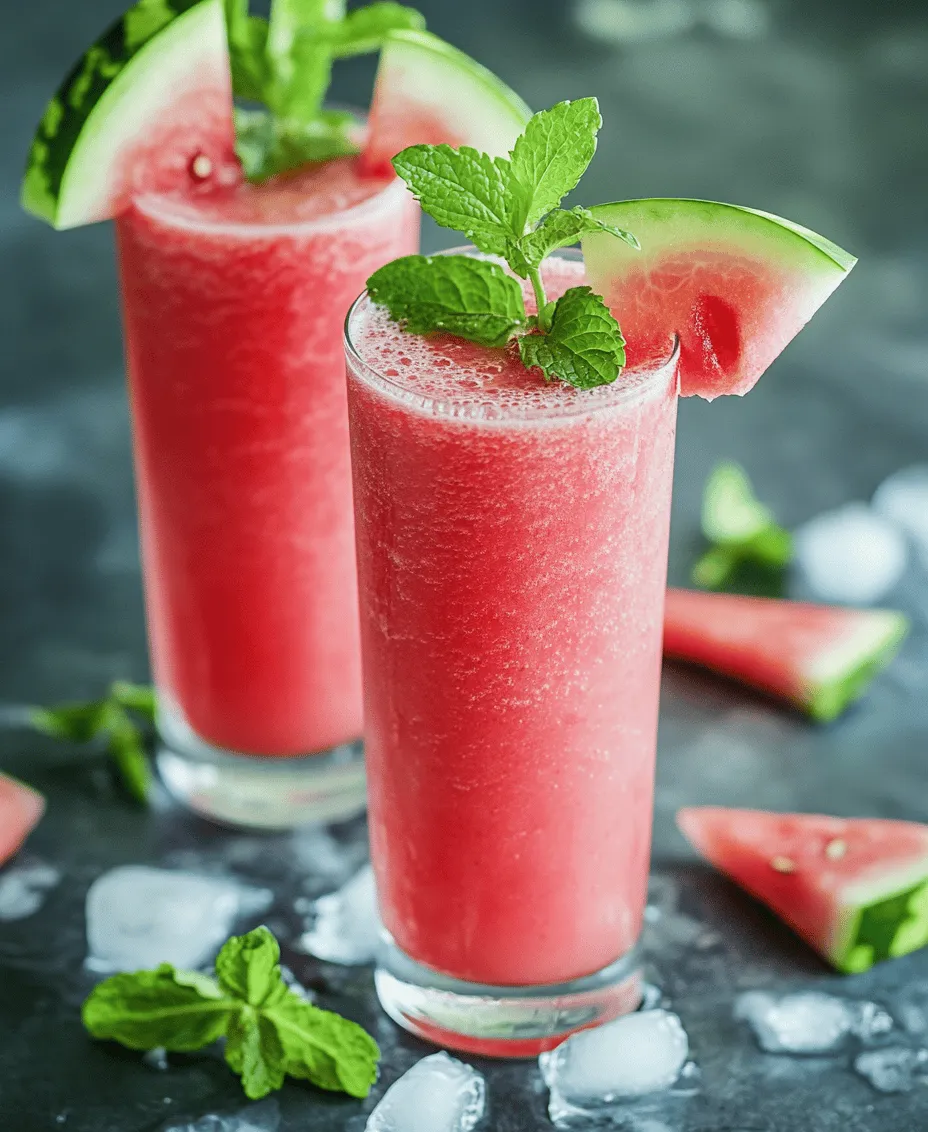Introduction
Smoothies have surged in popularity over the past few years, becoming a staple in many health-conscious diets. They offer a convenient, delicious way to incorporate fruits and vegetables into our daily intake while providing a refreshing burst of flavor. As summer approaches and temperatures rise, the need for hydrating beverages becomes increasingly important. This is where the Watermelon Smoothie with Coconut Water shines as an ideal choice.
Watermelon, known for its high water content, is an excellent fruit for hydration. It contains about 92% water, making it one of the most hydrating fruits available. Paired with coconut water, often referred to as “nature’s sports drink,” this smoothie not only quenches your thirst but also replenishes essential electrolytes lost during hot summer days. Together, these ingredients create a delightful and refreshing beverage that is perfect for keeping you cool, energized, and satisfied throughout the day.
In this article, we will explore the delightful combination of watermelon and coconut water in this smoothie recipe. We will also delve into the nutritional benefits of each ingredient, and provide a step-by-step guide to making this scrumptious drink. Let’s get started on how to make your new favorite summer beverage!
Understanding the Ingredients
Watermelon: A Hydration Powerhouse
Watermelon is often celebrated for its refreshing taste, but its health benefits extend far beyond just hydration. With a low calorie count and high water content, watermelon can help you stay full while keeping your calorie intake in check. A single cup of diced watermelon contains only about 46 calories, making it a guilt-free snack or smoothie ingredient.
From a nutritional standpoint, watermelon is rich in vitamins A and C, both of which are vital for maintaining healthy skin and supporting your immune system. Additionally, watermelon contains lycopene, a powerful antioxidant that has been linked to various health benefits, including reduced risk of certain types of cancer and heart disease.
When preparing a watermelon smoothie, it’s essential to use seedless watermelon. Not only does this make the blending process smoother and easier, but it also ensures a creamier texture without the crunchy distraction of seeds. If you can find it, look for ripe, sweet watermelon that has a deep red hue, indicating its high lycopene content.
Coconut Water: Nature’s Electrolyte Drink
Coconut water has gained immense popularity in recent years, especially among athletes and those seeking natural hydration solutions. Extracted from young green coconuts, coconut water is a clear liquid that is low in calories and high in electrolytes, including potassium, sodium, and magnesium. These electrolytes are crucial for maintaining fluid balance in the body, making coconut water a great choice for hydration after exercise or during hot weather.
Compared to traditional sports drinks, coconut water stands out for its natural composition and lack of added sugars or artificial ingredients. Many health enthusiasts appreciate its ability to replenish electrolytes without the excessive calories or chemicals found in many commercial hydration options. Moreover, coconut water is also a source of antioxidants, which help combat oxidative stress and support overall health.
Greek Yogurt: Creamy and Nutritious
While watermelon and coconut water form the base of our smoothie, adding Greek yogurt introduces a creamy texture and a boost of protein. Greek yogurt is not only delicious but also offers numerous health benefits, including improved gut health due to its probiotic content. This fermented dairy product is also rich in calcium, which is essential for maintaining strong bones and teeth.
For those who are lactose intolerant or following a plant-based diet, there are excellent dairy-free alternatives available, such as almond milk yogurt or coconut yogurt. These options can provide similar creaminess and flavor without the dairy, making them a versatile choice for anyone looking to enjoy a smoothie.
The Sweet Touch: Honey or Agave Syrup
To enhance the flavor of our Watermelon Smoothie, a natural sweetener is often needed. Honey and agave syrup are two popular choices that can add just the right amount of sweetness without overwhelming the natural flavors of the ingredients. Honey is a natural sweetener with anti-inflammatory properties and may even help soothe sore throats. Agave syrup, derived from the agave plant, is another excellent alternative with a lower glycemic index than sugar, making it a better option for those watching their blood sugar levels.
When adding sweeteners, it’s essential to taste as you go. Start with a small amount and adjust based on your preference. The sweetness of the watermelon can vary, so you may find you need less or more sweetener depending on the ripeness of the fruit.
Fresh Mint and Lime Juice: Flavor Enhancers
To elevate the flavor profile of your Watermelon Smoothie, fresh mint and lime juice serve as perfect complements. Mint adds a refreshing aroma and a burst of flavor that can brighten up the overall taste of the smoothie. It can also aid digestion and has a cooling effect, making it an excellent addition during hot summer months.
Lime juice plays a crucial role in balancing the flavors of the smoothie. Its acidity cuts through the sweetness of the watermelon and honey, adding a zesty kick that enhances the overall experience. Lime is also rich in vitamin C, which supports your immune system and enhances iron absorption.
Step-by-Step Guide to Making the Watermelon Smoothie
Preparation and Chilling the Ingredients
Before you begin blending, it’s important to prepare your ingredients properly. Start by selecting a ripe watermelon and cutting it into cubes, removing the rind and any seeds if necessary. For the best flavor and texture, chill the watermelon cubes in the refrigerator for at least an hour before making your smoothie. Chilling the ingredients not only enhances the refreshing quality of the drink but also eliminates the need for excessive ice, which can dilute the flavor.
Next, if you’re using Greek yogurt, consider placing it in the freezer for about 15-20 minutes before blending. This will help create a thicker, creamier smoothie. Likewise, ensure your coconut water is well chilled to enhance the overall refreshment of the drink.
Blending Process Explained
Once your ingredients are prepped and chilled, it’s time to blend your Watermelon Smoothie. Begin by adding the chilled watermelon cubes to your blender. Follow this by pouring in your coconut water, Greek yogurt, and any sweeteners you’ve chosen. If you prefer a thicker smoothie, you can add a handful of ice at this stage, but remember that too much ice can compromise the flavor.
Start blending on a low speed, gradually increasing to high. This will ensure that all ingredients combine smoothly without clumping. Blend for about 30 seconds to a minute, or until the mixture reaches your desired consistency. If the smoothie is too thick, feel free to add more coconut water a little at a time until you reach the perfect texture.
Once blended, you can taste your smoothie and adjust the sweetness or acidity by adding more honey (or agave syrup) and lime juice as needed. If you want a more pronounced mint flavor, consider adding a few mint leaves directly into the blender for a final blend.
With these steps, you’ll be well on your way to enjoying a delicious and hydrating Watermelon Smoothie with Coconut Water, perfect for those warm summer days or anytime you need a refreshing treat.



